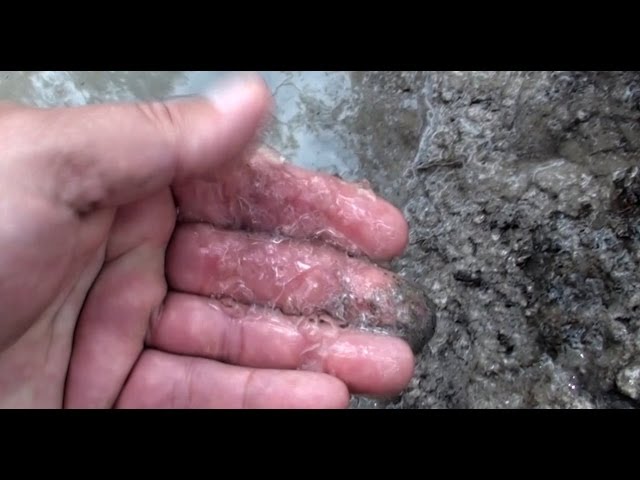Having a pond in your garden or backyard can be a beautiful and serene addition to your outdoor space. However, a leak in the pond can be a frustrating and concerning problem. Not only does it disrupt the aesthetics of your pond, but it can also lead to water loss and potential damage to the surrounding area. In this article, we will explore some effective methods for identifying and stopping a leak in a pond, allowing you to restore the beauty and functionality of your water feature.
:max_bytes(150000):strip_icc()/101696984-1f18c2a4a83147d09352858e464a2264.jpg)
Credit: www.agriculture.com
Identifying the Leak
The first step in addressing a leak in your pond is to identify the source of the problem. This can be a challenging task, as water features can have multiple potential points of leakage. One of the most common signs of a leak is a decrease in water level that cannot be attributed to evaporation or splashing. You may also notice wet or soggy areas around the pond, indicating that water is escaping from the structure.
To pinpoint the location of the leak, you can perform a simple water level test. Fill the pond to its normal level and mark the water line. Then, turn off any pumps or fountains and monitor the water level over a 24-hour period. If the water level drops significantly, you likely have a leak that needs to be addressed.
Fixing the Leak
Once you have identified that your pond is indeed leaking, it’s time to take action to stop the escape of water. There are several methods and products available for repairing pond leaks, and the most suitable approach will depend on the nature and severity of the leak.
Sealants And Liners
If the leak is due to a small crack or puncture in the pond liner, you may be able to fix it using a specialized sealant. These sealants are designed to adhere to the liner material and create a watertight seal, effectively patching the damaged area. Be sure to clean and dry the affected area before applying the sealant, and follow the manufacturer’s instructions for the best results.
For more extensive damage or deterioration of the pond liner, you may need to consider replacing the liner altogether. Modern pond liners are often made from durable, flexible materials such as EPDM rubber or PVC, providing a long-lasting and reliable barrier against leaks. Investing in a high-quality liner can provide peace of mind and prevent future issues with leakage.
Underwater Patching
If the leak is located in a difficult-to-reach area of the pond, such as near rocks or plants, you may need to utilize an underwater patching product. These specialized materials are designed to set and cure underwater, allowing you to make repairs without draining the pond. Look for a patching compound that is safe for fish and other aquatic life, and carefully follow the application instructions for the best results.
Professional Assistance
In some cases, identifying and repairing a leak in a pond may require the expertise of a professional. Pond maintenance and repair specialists have the knowledge, tools, and experience to diagnose and address leaks effectively. They can also provide valuable advice on preventing future leaks and maintaining the overall health of your pond ecosystem.
Preventing Future Leaks
Once you have successfully stopped the leak in your pond, it’s important to take steps to prevent future issues from arising. Regular maintenance and attentive care can go a long way in preserving the integrity of your pond and minimizing the risk of leaks.
Inspecting And Cleaning
Regularly inspect the pond liner for signs of wear, damage, or deterioration. Look for any areas that may be vulnerable to leaks, such as where the liner meets rocks or other hard surfaces. Keeping the pond clean and free of debris can also help to prevent damage to the liner and reduce the risk of leaks.
Monitoring Water Quality
Maintaining a healthy balance of water quality in your pond can contribute to the longevity of the liner and overall structural integrity. Proper filtration, aeration, and regular water testing can help to prevent the buildup of harmful substances that may degrade the pond liner and lead to leaks.
Protective Measures
Consider adding protective measures to your pond, such as placing a layer of sand or protective fabric beneath the liner to cushion it from sharp objects or roots. Additionally, be mindful of the placement of rocks and decorative elements to minimize the risk of puncturing or damaging the liner over time.

Credit: www.youtube.com
Conclusion
Stopping a leak in a pond requires careful assessment, targeted repair efforts, and ongoing maintenance to prevent future issues. By identifying the source of the leak, utilizing appropriate repair methods, and implementing preventive measures, you can effectively restore the integrity of your pond and enjoy its beauty for years to come.
Remember, a well-maintained pond not only enhances the visual appeal of your outdoor space but also provides a habitat for aquatic life and contributes to the overall tranquility of your environment. With the right approach, you can address and prevent leaks, ensuring that your pond remains a vibrant and sustainable feature of your landscape.




